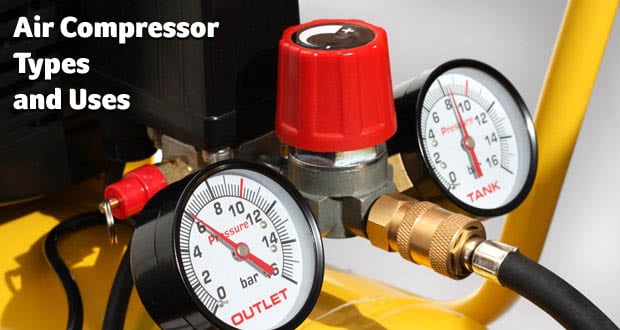Well, this article will show you about air compressor types and uses. So if you keep reading the full article, you can gather knowledge on the topic. Then let’s go.
In the current market there are many types of air compressors, with different sizes, working power and output pressures. If you’re looking for a compressor that meets your requirements, it’s convenient that you at least know how it works. So to learn details about air compressor types and uses, keep reading the article.

Compressors may seem difficult to understand, however, most of them follow the same basic principle. Today you’ll know the main types of air compressors and their most common uses.
Hope, after reading the article, you will gather huge knowledge on air compressor types and uses. So let’s go.
Contents:
Air Compressor Types and Uses is Hard Topic?
Are you a science student? If yes, then you can understand the topic easily. But if you are not, then you need some extra efforts. What type of extra work?
Well, you have to gather some knowledge of basic air compressor. So you need to learn about how to works an air compressor and the behind science. If you can know the story, you can easily. So, then, you can see, the topic is not so hard.
Sounds good?
Then keep reading our blog to know in details.
Types of Air Compressor
There are 2 main groups of air compressors: positive displacement and dynamic. However, the main function of all compressors is the same: increasing air pressure through different methods. I am going to write in few more details.
1. Positive Displacement
Positive displacement compressors increase pressure by compressing large air volumes in a small space (chamber). When the cabin reaches its maximum pressure, then release the air automatically.
Positive displacement air compressors are two types:
— Reciprocating, and
— Rotary
Reciprocating Compressors
Reciprocating compressors suck air through a piston driven by a connecting rod and a crankshaft. Piston rises. So compress the air. That’s why its discharge the valve.
The best known reciprocating compressors are: single-acting, double-acting and diaphragm.
Single-acting compressors compress the air using only one side of the piston. Double-acting compressors use both sides of a piston to do the same.
Diaphragm compressors use a connecting rod and a piston to force a membrane to suck and expel air continuously. During the process (similar to lung breathing), air doesn’t come into contact with oil from moving parts.
The air is expelled and accumulates within a chamber to generate pressure. As the air remains unpolluted, diaphragm compressors are often used in pharmaceutical and food industries.
Rotary Compressors
This is use two helical rotors to suck air into a cylinder and push it into a smaller diameter duct. During the process, oil is injected as a lubricant, also helping to lower internal temperature.
Part of the compressed air contains oil particles that are retained in a filter. However, the resulting air isn’t completely pure, so these types of compressors aren’t recommended in food or electronics industries.
Rotary compressors are classified as: lobe, liquid ring, screw and vane.
To buy an air compressor within budget price, just click here.
2. Dynamic
Dynamic compressors accelerate and decelerate air to change its pressure.
Compared to reciprocating compressors, dynamic compressors are easier to maintain, since they don’t require oil to operate. This implies a large cost reduction in lubricants and other spare parts.
Dynamic compressors are two types as below:
— Centrifugal
— Axial.
Centrifugal Compressors increase air pressure by increasing its kinetic energy. Basically, impellers accelerate the air and static pressure increases when the accelerated fluid passes through a diffuser.
The efficiency of these devices makes them the most suitable for applications with power requirements above 250 HP, being able to exceed 6,000 HP if necessary.
Axial Compressors increase air speed in the axial direction by rotating a shaft provided with rotor blades. A clear example of this principle is the operation of turbines on airplanes and ships.
Rotor blades are curved metal vanes that work just like a fan’s propeller. The blades recover kinetic energy of the air by accelerating its particles.
As with centrifugal compressors, the air pressure in an axial compressor increases when it passes through a diffuser.
Air Compressor Uses
As explained above, dynamic compressors are used in high performance work, where high power values are required. Instead, positive displacement compressors are used in more common tasks.
Positive displacement compressors are used to pump gas, oil and other fluids. In different industries, these compressors are used to feed pistons to open gates and controlling other hydraulic devices.
The plastic and glass packaging industries use them to inject compressed air into the hot material.
Smaller versions are used at gas stations to inflate tires and in homes. And to feed paint guns and other air tools.
In the oil industry, they use dynamic compressors to pump natural gas. Its need to crude oil deposits during the extraction process. They also use air, nitrogen gas and other gases too.
Conclusion
Each different job requires a different compressor. Surely, after knowing better a compressor’s operation, you’ll have a better criterion to choose the most suitable for you.
Remember that the required power, output pressure and using purpose are factors that you shouldn’t overlook when choosing your compressor.
If you clearly know your requirements, you won’t fail when you make a decision.
